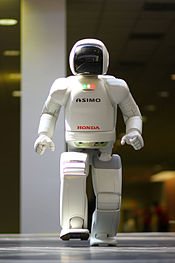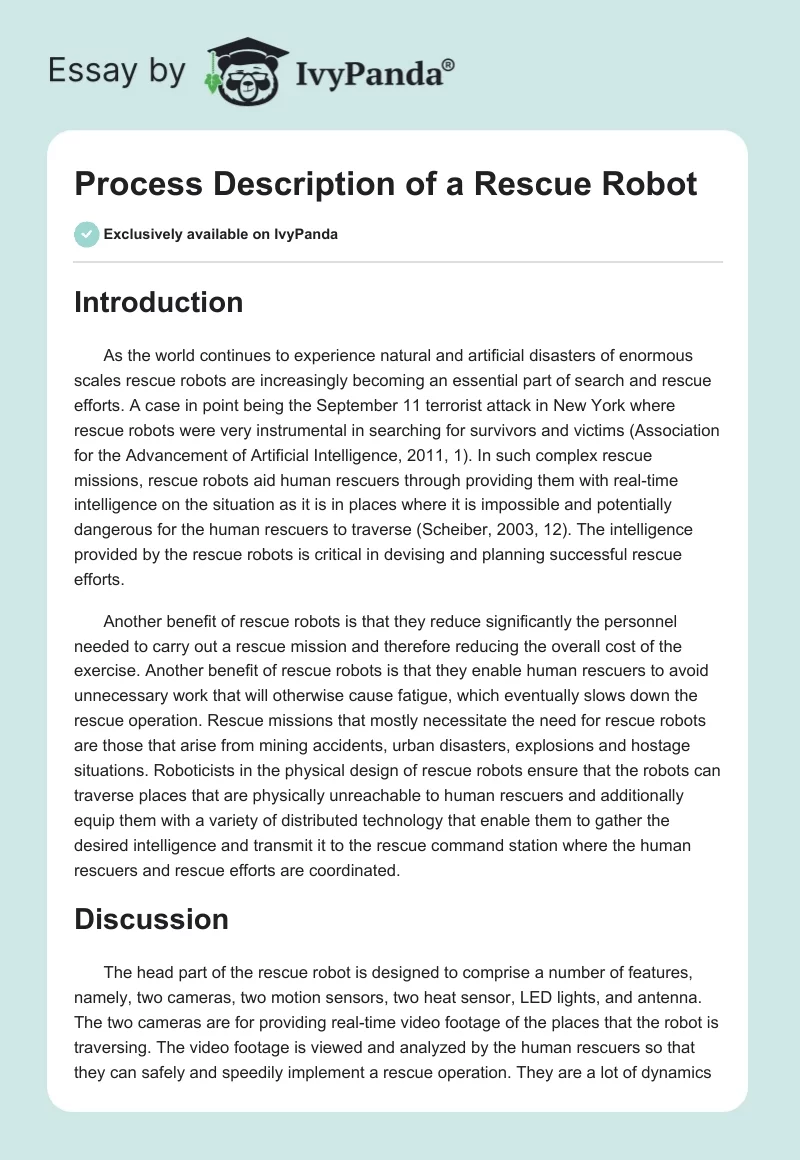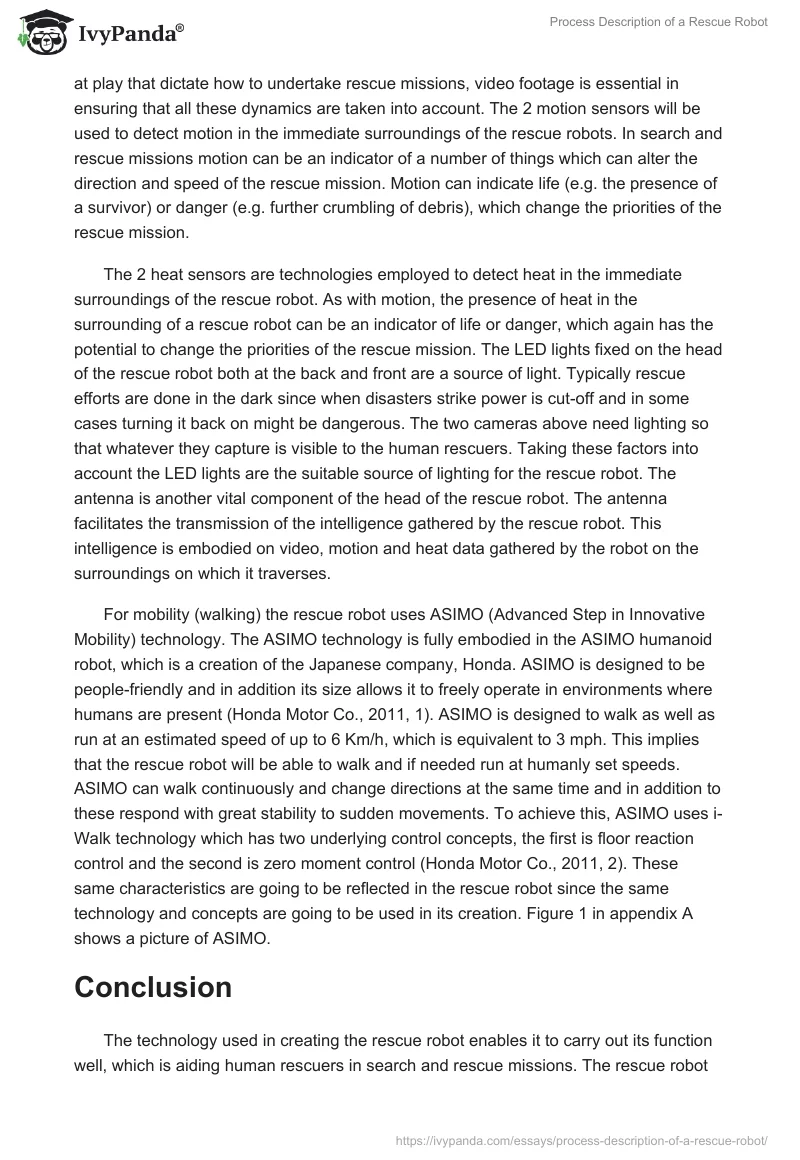Introduction
As the world continues to experience natural and artificial disasters of enormous scales rescue robots are increasingly becoming an essential part of search and rescue efforts. A case in point being the September 11 terrorist attack in New York where rescue robots were very instrumental in searching for survivors and victims (Association for the Advancement of Artificial Intelligence, 2011, 1). In such complex rescue missions, rescue robots aid human rescuers through providing them with real-time intelligence on the situation as it is in places where it is impossible and potentially dangerous for the human rescuers to traverse (Scheiber, 2003, 12). The intelligence provided by the rescue robots is critical in devising and planning successful rescue efforts.
Another benefit of rescue robots is that they reduce significantly the personnel needed to carry out a rescue mission and therefore reducing the overall cost of the exercise. Another benefit of rescue robots is that they enable human rescuers to avoid unnecessary work that will otherwise cause fatigue, which eventually slows down the rescue operation. Rescue missions that mostly necessitate the need for rescue robots are those that arise from mining accidents, urban disasters, explosions, and hostage situations. Roboticists in the physical design of rescue robots ensure that the robots can traverse places that are physically unreachable to human rescuers and additionally equip them with a variety of distributed technology that enable them to gather the desired intelligence and transmit it to the rescue command station where the human rescuers and rescue efforts are coordinated.
Discussion
The head part of the rescue robot is designed to comprise a number of features, namely, two cameras, two motion sensors, two heat sensors, LED lights, and antenna. The two cameras are for providing real-time video footage of the places that the robot is traversing. The video footage is viewed and analyzed by the human rescuers so that they can safely and speedily implement a rescue operation. They are a lot of dynamics at play that dictate how to undertake rescue missions, video footage is essential in ensuring that all these dynamics are taken into account. The 2 motion sensors will be used to detect motion in the immediate surroundings of the rescue robots. In search and rescue missions motion can be an indicator of a number of things which can alter the direction and speed of the rescue mission. Motion can indicate life (e.g. the presence of a survivor) or danger (e.g. further crumbling of debris), which changes the priorities of the rescue mission.
The 2 heat sensors are technologies employed to detect heat in the immediate surroundings of the rescue robot. As with motion, the presence of heat in the surroundings of a rescue robot can be an indicator of life or danger, which again has the potential to change the priorities of the rescue mission. The LED lights fixed on the head of the rescue robot both at the back and front are a source of light. Typically rescue efforts are done in the dark since when disasters strike power is cut off and in some cases turning it back on might be dangerous. The two cameras above need lighting so that whatever they capture is visible to the human rescuers. Taking these factors into account the LED lights are the suitable source of lighting for the rescue robot. The antenna is another vital component of the head of the rescue robot. The antenna facilitates the transmission of the intelligence gathered by the rescue robot. This intelligence is embodied on video, motion and heat data gathered by the robot on the surroundings on which it traverses.
For mobility (walking) the rescue robot uses ASIMO (Advanced Step in Innovative Mobility) technology. The ASIMO technology is fully embodied in the ASIMO humanoid robot, which is a creation of the Japanese company, Honda. ASIMO is designed to be people-friendly and in addition, its size allows it to freely operate in environments where humans are present (Honda Motor Co., 2011, 1). ASIMO is designed to walk as well as run at an estimated speed of up to 6 Km/h, which is equivalent to 3 mph. This implies that the rescue robot will be able to walk and if needed run at humanly set speeds. ASIMO can walk continuously and change directions at the same time and in addition to these respond with great stability to sudden movements. To achieve this, ASIMO uses i-Walk technology which has two underlying control concepts, the first is floor reaction control and the second is zero moment control (Honda Motor Co., 2011, 2). These same characteristics are going to be reflected in the rescue robot since the same technology and concepts are going to be used in its creation. Figure 1 shows a picture of ASIMO.

Conclusion
The technology used in creating the rescue robot enables it to carry out its function well, which is aiding human rescuers in search and rescue missions. The rescue robot is able to gather different data and transmit it to the control center, which as discussed above is critical in devising and planning rescue operations. The ASIMO technology used in the robot enables it to have flexible and advanced mobility, which is essential in helping it carry out its work. It is important that as technology advances the rescue robot is continuously improved so as to maintain and ensure high levels of efficiency.
Reference List
Association for the Advancement of Artificial Intelligence. (2011). In the aftermath of September 11 what roboticists learned from the search and rescue efforts. Web.
Honda Motor Co. (2011). Design concept technology. Web.
Honda Motor Co. (2011). Walking technology. Web.
Scheiber, D. (2003) Robots to the rescue. St. Petersburg Times. Web.


